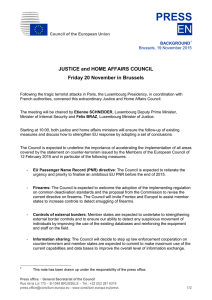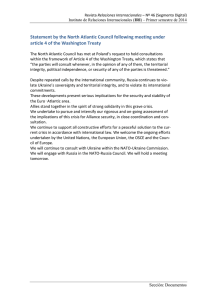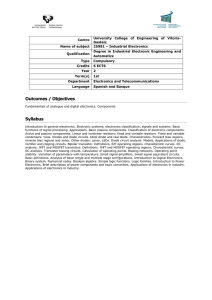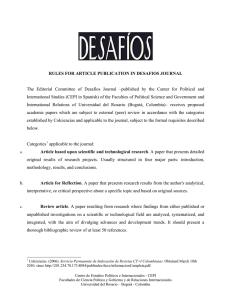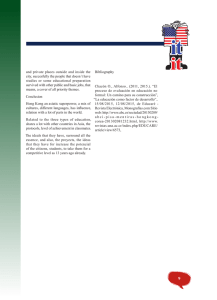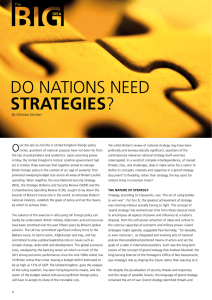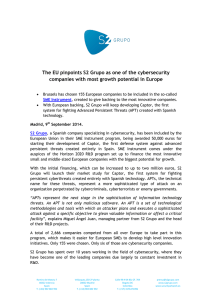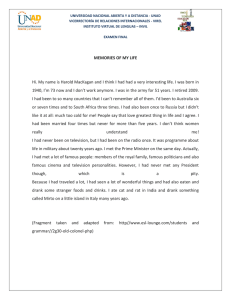Criticizing the EU Security Strategy - Revista Electrónica de Estudios
Anuncio
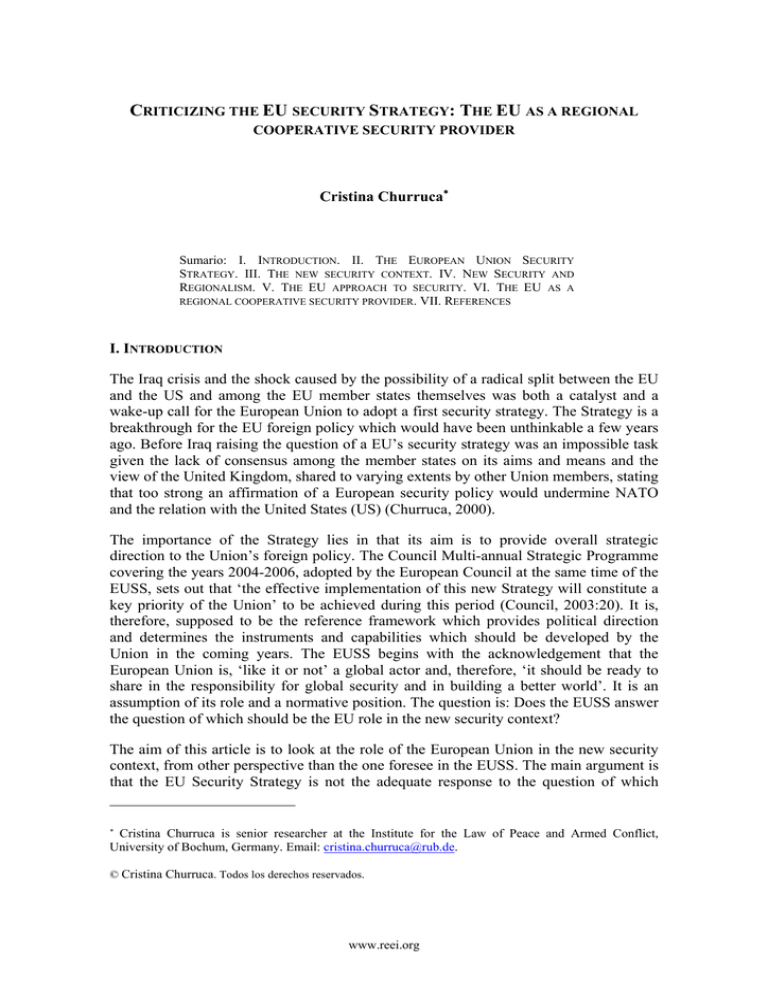
CRITICIZING THE EU SECURITY STRATEGY: THE EU AS A REGIONAL COOPERATIVE SECURITY PROVIDER Cristina Churruca∗ Sumario: I. INTRODUCTION. II. THE EUROPEAN UNION SECURITY STRATEGY. III. THE NEW SECURITY CONTEXT. IV. NEW SECURITY AND REGIONALISM. V. THE EU APPROACH TO SECURITY. VI. THE EU AS A REGIONAL COOPERATIVE SECURITY PROVIDER. VII. REFERENCES I. INTRODUCTION The Iraq crisis and the shock caused by the possibility of a radical split between the EU and the US and among the EU member states themselves was both a catalyst and a wake-up call for the European Union to adopt a first security strategy. The Strategy is a breakthrough for the EU foreign policy which would have been unthinkable a few years ago. Before Iraq raising the question of a EU’s security strategy was an impossible task given the lack of consensus among the member states on its aims and means and the view of the United Kingdom, shared to varying extents by other Union members, stating that too strong an affirmation of a European security policy would undermine NATO and the relation with the United States (US) (Churruca, 2000). The importance of the Strategy lies in that its aim is to provide overall strategic direction to the Union’s foreign policy. The Council Multi-annual Strategic Programme covering the years 2004-2006, adopted by the European Council at the same time of the EUSS, sets out that ‘the effective implementation of this new Strategy will constitute a key priority of the Union’ to be achieved during this period (Council, 2003:20). It is, therefore, supposed to be the reference framework which provides political direction and determines the instruments and capabilities which should be developed by the Union in the coming years. The EUSS begins with the acknowledgement that the European Union is, ‘like it or not’ a global actor and, therefore, ‘it should be ready to share in the responsibility for global security and in building a better world’. It is an assumption of its role and a normative position. The question is: Does the EUSS answer the question of which should be the EU role in the new security context? The aim of this article is to look at the role of the European Union in the new security context, from other perspective than the one foresee in the EUSS. The main argument is that the EU Security Strategy is not the adequate response to the question of which ∗ Cristina Churruca is senior researcher at the Institute for the Law of Peace and Armed Conflict, University of Bochum, Germany. Email: [email protected]. © Cristina Churruca. Todos los derechos reservados. www.reei.org 10 REVISTA ELECTRÓNICA DE ESTUDIOS INTERNACIONALES (2005) should be the EU role in the new security context. In my view, this question should be answered taking into consideration the type of actor the EU is and the instruments at its disposal, and building up on the Union’s already existing security approach. The EU cooperative and comprehensive security approach is particularly well suited to address the challenges of the new security context. The EU, which is the most advanced supranational regional arrangement in the world, should make the best of its particular added value and comparative advantage as a cooperative security provider instead of trying to match the United States. Being a paradigm of the ‘New regionalism’ the European Union offers an alternative model and a different view of the world order to US unilateralism. Starting from a critique of the EUSS, this article explores how the broadening meaning of security and of what constitutes threats to security have created a new context which demands a cooperative and holistic approach to security and in which the region emerges as an essential security referent. Then, it will discuss the main ideas of the ‘New security and Regionalism’ perspective and the EU current approach to security in order to show that from this view, which emphasizes the cooperative aspects of regionalization processes as responses to globalization and embraces the new security issues, and on the bases of EU actual policies we can look at the role of the EU in different terms that the ones put forward by the EUSS. II. THE EUROPEAN UNION SECURITY STRATEGY The document entitled ‘A secure Europe in a better world. European Security Strategy’ (EUSS) adopted by the Brussels European Council in December 2003 highlights the current global challenges and key security threats, identifies the EU’s strategic objectives and draws on the policy implications for the Union (EUSS, 2003). It is the first European Council’s attempt to give overall strategic direction to the Union’s foreign policy. The EUSS recognises that Europe should be ready to share in the responsibility for global security and in building a ‘better world’ acting together with the USA. In order to do so the strategy focuses on the need to be more active, more coherent and more capable. This is a call to match its objectives with its instruments which has to be seen in the light of the institutional reforms discussed in the European Convention and included to an extent in the EU Constitutional Treaty, and of the enlargement. The strategy points out some global challenges that ‘give rise to security concerns’ and others that are considered ‘key threats’. The key threats identified are: terrorism, proliferation of weapons of mass destruction, regional conflicts, failed states, state failure and organised crime (EUSS: 3-4).1 It acknowledges that these five elements taken together could confront the European Union with a very radical threat. Violent 1 To compare, the UN High Level Panel on Threats, Challenges and Change has sorted out six clusters of threats for international peace and security: economic and social threats, including poverty, infectious diseases and environmental degradation; inter-State conflict; internal conflict, including civil war, genocide and other large -scale atrocities; nuclear, radiological, chemical and biological weapons; terrorism and transnational organized crime (UN, 2004:11). -2- Criticizing the EU Security Estrategy… conflict, poverty and disease, especially AIDS, competition for natural resources and energy dependence fall into the category of security concerns (Ibid.). On the basis of these security challenges the Strategy identifies as its first strategic objective addressing the threats. The other two objectives are building security in its neighbourhood and effective multilateralism (Ibid: 7-10). In order to be more capable the strategy points out the actions underway to transform its military forces and strengthen the CFSP’s civilian and military crisis management capabilities, what is known as the European Security and Defence Policy (ESDP) (Ibid.12). The EUSS makes the casual link between ‘new’ threats (terrorism, WMD, state failure, organised crime) and the ‘older’ problems of ‘regional conflicts (EUSS, 4). However it does not place enough emphasis on addressing the root causes of both new and old threats. Terrorism can, for example have similar common causes to violent conflict. Poverty provides the background for alienation and resentment which fuels conflict as well as helps terrorist with their recruitment activities. Yet, poverty and disease are only mentioned among the global challenges and not as strategic objectives to be achieved. Neither the increasing world inequality gap is perceived as a threat. In fact there is no real recognition of the interdependence between rich and poor countries except for the possibility of the later fuelling terrorism and WMD (EUSS, 2003:4). The strategy recognises the regional dimensions of conflict. An important aspect of the EU emergent approach to security, which is hidden among the policy implications, is the reference to the need of coherent policies ‘regionally, especially in dealing with conflict` (EUSS: 2003, 13). The document recognises that ‘problems are rarely solved on a single country basis, or without regional support, as in different ways experience in both the Balkans and West Africa shows’ (Ibid.) However regional approaches to preventing conflict, and strengthening regional structures and organisations are not really captured in the policy implications. This is surprising when the EU is in itself a peace and security project. Security concerns were and are the driving force of the European integration process. The basic intention of Europe’s founders was the prevention of war through peace reconciliation based on economic recovery and progress through gradual integration. Over the last five decades, the Member States have developed between them a real Community of security within which it is inconceivable that there would be the slightest threat of recourse to force as a means of settling disputes (see Tiersky 1999; Bretherton and Vogler 1999). Another surprise is the absence of any reference to the common values shared by the Member States (human rights, democratisation and the rule of law) which are first the foundations of the European identity, second and in connection with the former, are actively promoted by the Union in its relations with third countries and in international and regional fora, and finally are considered the foundation of peace, of security. When dealing with threats, there is a reference to ‘restoring good government to the Balkans and fostering democracy’ (EUSS: 6), (by the way the only time the word democracy is used in the document with the exception of the introduction) and in building security in the neighbourhood (the document refers there to ‘well governed states’ (Ibid: 8). No explicit mention to human rights is to be found. Only when dealing with the objective of effective multilateralism, the document makes a passing reference to ‘well-governed democratic states’ and ‘establishing the rule of law and protecting human rights’ as the best means of strengthening the international order (Ibid.10). -3- 10 REVISTA ELECTRÓNICA DE ESTUDIOS INTERNACIONALES (2005) While the EUSS recognises the changed nature of the security environment, it fails to encompass wider concepts of human security and its subsequent policy implications. It prioritises military responses and enhancing military capabilities over civilian soft instruments. The focus of the strategy is not long-term preventive action but short-term crisis management. It is more than clear: ‘Active policies are needed to counter the new dynamic threats. We need to develop a strategic culture that fosters early, rapid and when necessary, robust intervention’ (Ibid.11). In fact the EUSS gives the impression of being to close to the National Security Strategy of the United States (NSS, 2002) which focuses very strongly on terrorism and WMD and the need of defence against them. The reason for this seems to be, as stated by Biscop who followed its cooking, that ‘the American threat assessment can be interpreted as a political statement, signalling to Washington, in the aftermath of the transatlantic divide over Iraq, that the EU shares the US concerns on the threats posed by terrorism and WMD’ (Biscop, 2004:17) not to forget the ‘old’ and the ‘new’ Europe divide in the Iraq crisis. Although the EU threat assessment can scarcely differ from analyses on the other side of the Atlantic (Müller, 2003) the type of response and policy that the European Union should worked out ought to be divergent. The US relies on military ‘hard’ power contrasts with the civilian and soft power of the EU. The EU military instruments are limited and are going to stay limited and intergovernmental. The absence of military power made of the European Community (EC) a civilian power by default, in Duchene’s original formulation a force for the promotion of peace and democratic principles in the world (Duchene, 1972; Stavridis 2001) as a contrast to the more traditional power politics model of superpower rivalry. The EU has a strong tradition of offering this model to the wider world and has promoted sustainable, democratic and economic solutions before military answers. Development policy and other co-operation programmes (European Commission, 2004) provide, without doubt, the most powerful instruments at the Union’s disposal for treating the root causes of conflict. But in contradiction with the EU development policy which considers development as a precondition of security, the document states that ‘Security is a precondition of development’ (EUSS, 2003:2). The EUSS dismisses that the reform of EU's Development Policy of 2000 was oriented to play an important pro-active and direct contribution to strengthen peace and stability (European Commission, 2000, Council and Commission, 2000). It established poverty reduction as the overarching aim of the EU’s development assistance and made of the fight against AIDS, malaria and other diseases a specific goal acknowledging that without addressing these diseases the central outcome of global poverty reduction will not be met (European Commission, 2003:43-46). Therefore the emphasis in addressing the symptoms instead of the root causes of insecurity is not consistent with the reality of a Union which, as a region, provides more than half of global development assistance: over EUR 30 billion in 2003, of which EUR 7,8 billion from the EU budget (European Commission, 2004:9). More than 40% of the latter funds provide assistance to Africa (Ibid: 177). The EU has taken on a leadership role in the fight against world poverty in becoming the largest aid donor (55% of global ODA). In this context the absence of any mention of the need to achieve the set of Millennium Development Goals (MDGs) within the final objective of establishing ‘an effective multilateral system’ is also regrettable (EUSS, 2003:9). Since 2000 the EU has -4- Criticizing the EU Security Estrategy… advocated a process to bring about a review of progress, the adoption of guidelines on common security issues, agreements to improve the implementation of commitments made pursuant to the Millennium Declaration and the MDGs, and decisions on the organisational reforms needed to achieve the objectives.2 III. THE NEW SECURITY CONTEXT With end of the Cold War and the intensification of global connectedness associated with the process of globalization and the rise of concerns with identity issues and transnational crime during the 1990s that a broader understanding of security and of what constitute threats to security openly emerges. Security becomes a multidimensional concept covering military, political, economic, environmental, and societal elements. The wider security agenda claims security status for issues and referent objects in the economic, environmental, and societal sectors as well as the military-political ones that define traditional security (Buzan, Waever and de Wilde, 1998). In an ‘Agenda for Peace’ the UN Secretary General recognises the complexity of the concept of security involving the proliferation of weapons of mass destruction, the availability of conventional arms; violent conflicts; new risks for stability produced by the communications revolution; the devastating problems of unchecked population growth; crushing debt burdens; barriers to trade, drugs and the growing disparity between rich and poor; poverty, disease, famine, oppression and despair abound being both sources and consequences of conflict; also new assertions of discrimination and exclusion and ‘acts of terrorism seeking to undermine evolution and change through democratic means’ (UN, 1992: parr.11-13). The process globalization has created new vulnerabilities to old threats. Also new dimensions of globalization have emerged creating ‘wholly new (security) contexts in which conventional institutional remedies fare poorly’ (UN, 2000: 11-12). Among the new factors that transcend boundaries and erode national cohesion, the most perilous are the so-called 'new risks': illegal drug trafficking, international organized crime and terrorism. Contrary to other global challenges (the communications revolution, water shortages, access to energy resources, financial flows, environmental concerns) ‘they call directly into question the very authority of the state, and are therefore potentially, if not openly, subversive’ (Politi, 1997: 2). In the post-September-11 world, the boundary between external and internal security has been completely blurred. In this context a renewed understanding of what security means has emerged: Human Security. The growing recognition worldwide that concepts of security must include people as well as states has marked an important shift in international thinking during the past decade. As the UN Secretary General’s Millennium Report noted a ‘new understanding of the concept of security is evolving,’ one that emphasises the need for a ‘human security’ framework (UN 2000:7). With the end of the Cold War, in the wake of internal conflicts involving gross violations of human rights that threaten to generate 2 See, ‘The European Commission's package on the Millennium Development Goals’ at http://europa.eu.int/comm/development/body/communications/communications_en.htm, 18. April 2005. -5- 10 REVISTA ELECTRÓNICA DE ESTUDIOS INTERNACIONALES (2005) wider instability or unacceptable human suffering, the requirements of security have come to embrace the protection of communities and individuals from internal violence. The need for a more human-centred approach to security is reinforced by the continuing dangers that weapons of mass destruction, terrorism and organised crime pose to humanity (UN, 2000:8). The respect and implementation of human rights and democratic principles has won ground as the best guarantees of peaceful, predictable and cooperative behaviour between states. The concept of human security is based on human rights but broader in its scope. Human security is concerned with safeguarding and expanding people's vital freedoms. It requires both protecting people from acute threats and empowering people to take charge of their own lives. Protection refers to the norms, policies, and institutions essential to shield people and implies a ‘top-down approach,’ such as the rule of law and democratic governance. Empowerment underscores the role of people as actors and participants and implies a ‘bottom-up’ approach. In this regard, human security does not seek to supplant state security, but rather to complement it. Human security thus ‘brings together the human elements of security, of rights, of development’. (ICHS, 2003: 4). It also underlines the global nature of security challenges that results in mutual vulnerability. The new security context has clear interrelated policy implications. Interdependent and trans-national problems need cooperative and holistic models of behaviour which emphasize the importance of conflict prevention as opposed to defensive pre-emptive attitudes defined in terms of national security (UN, 2000: 44-46) (the limits of US strategy in Afghanistan and in Iraq have been largely probed). The most comprehensive approach to security has been developed in Europe by OSCE (Adler, 1998). This approach is one of co-operative security based on democracy, respect for human rights, fundamental freedoms and the rule of law, market economy and social justice (OSCE, 1996: point 3). It considers ‘the protection and promotion of human rights and fundamental freedoms, along with economic and environmental cooperation […], to be just as important for the maintenance of peace and stability as politico-military issues’ (OSCE, 2000: 1-3). This notion enhances the complementarities of the various dimensions of security. Security is not only determined by political and military factors but relates the maintenance of peace to the respect for human rights and fundamental freedoms and includes also cooperation on social, economic, and ecological issues. Therefore, security does not only include one’s own, it is indivisible. The various aspects of security are seen as interconnected and interdependent. This approach to security has been adopted by the UN High Level Panel on Threats, Challenges and Change which argues for a broader, more comprehensive concept of collective security: one that addresses all of the major threats to international peace and security felt around the world and all the responsibilities, commitments, strategies and institutions that come with it (UN, 2004:11). The underlying assumption is that today’s threats recognize no national boundaries, are connected, and must be addressed at the global and regional as well as the national levels. The post–September 11 world clearly related the importance of non-state actors and of the developing world within a regional context. It also proved that development and security are interdependent. This means that although new risks and threats could need short-term coercive responses, the main -6- Criticizing the EU Security Estrategy… emphasis should be put on underlying the causes of insecurity. That is placing development and human security in the centre. IV. NEW SECURITY AND REGIONALISM The region has emerged as an essential security referent in the post-Cold War world. The regional level is where the extremes of national and global security interplay. In the words of David Lake’s and Patrick Morgan’s `Efforts to cope with violent conflicts, as well as to achieve order and security, will primarily involve arrangement and actions devised and implemented at the regional level […] The regional level stands more clearly on its own as the focus of conflict and cooperation for states and as the level of analysis for scholars seeking to explore security affairs’ (Lake and Morgan, 1997: 5-7). The region understood in security terms as some sort of a distinct and significant subsystem of security relations among a set of states and non-state actors that are locked into geographical proximity with each other (Buzan, 1991) finds its most developed expression in the European Union. The integration process has transformed a security complex into a security community (Adler and Barnett, 1998) which has blurred distinctions between internal and external security and has ‘collectivised’ national security. Nevertheless, this is an exception. The security dynamics that have unfolded in other regions like the Balkans, Caucasus, Horn of Africa, Central Africa, West Africa, Central Asia, and the Middle East are based on patterns of conflict, suspicion, and fear. As Hentz explains with respect to the cases of Africa and Central Asia ‘the interplay of strong and weak states, and the formal and informal regionalisms for which they are responsible, shapes new realities on the ground with concomitant security challenges’ (Hentz,2003:12). These dynamics show the interplay of ethnic identities, criminal gangs, warlord factions, armed forces, terrorist groups, trans-national and multinational corporations, and foreign governments, NGOs, civil society groups, and individuals. (see Kaldor, 1999; Quadir, 2003; Boas, 2003, Shaw, 2003). This implies that the regional referent is partially defined by its interaction with actors both at the local and at the international level. This means that conflict in many cases is part of an exchange network. It is part of globalization (Duffield, 2001; Kaldor, 1999).3 Buzan and Waever explore in Regions and Powers the Structure of International Security the idea that, since decolonisation, the regional level of security has become both more autonomous and more prominent in international politics (Buzan and Waever 2003: 3). Their central premise is that ‘since most threats travel more easily over short distances than over long ones, security interdependence is normally patterned into regional based clusters: security complexes’ (Ibid.: 4). According to Buzan and Waever in order to qualify as a security complex ‘a group of states or other entities must posses a degree of security interdependence sufficient both to establish them as a linked set and to differentiate them from surrounding security regions’ (Ibid.: 47-48). 3 These forms of violence are reproduced through an ‘extreme form of globalization’ in which production collapses and armed forces are sustained via remittances, diaspora fund-raising, external governmental assistance and the diversion of international humanitarian aid or a few valuable commodities continue to be produced – e.g. diamonds in Angola and Sierra Leone, lapis lazuli, and emeralds and drugs in Afghanistan , drugs in Colombia and .Tajikistan. ( Kaldor, 1999: 101-107. -7- 10 REVISTA ELECTRÓNICA DE ESTUDIOS INTERNACIONALES (2005) Regional security complexes theory (RSCT) builds on a previous work of the Copenhagen School’s of security studies, Security: a New Framework for Analysis (1998) which laid the foundations for thinking about regional security in the context of a wider security agenda and a securitisation approach. The later offers a comprehensive framework for analysing security which goes beyond the ‘wide’ and the ‘narrow’ debate about security by exploring threats to referent objects, the securitization of those threats and the interrelated the globalizing, regionalizing and localizing tendencies in the security debates about the referent objects and threats in each sector in order to assess the importance of securitization at the different levels of analysis.4 According to this approach, ‘security’ is what actors make of it, and it is for the analyst to map its practices. The process of securitisation is what in language theory is called a speech act (Buzan et al., 1998:26). The Copenhagen regional security complex theory has the value of offering from a regionalist perspective a constructivist approach that focuses on the political processes by which security issues are constituted. However, it fails to grasp the challenges of the new security context. RSCT remains predominantly state-centric. It dismisses the role of non-sate actors. The dynamics of securitisation are embedded in a formally anarchic system where, as actors see each other as security problems, the patterns of conflict dominate. How to apply this framework to the EU? ‘Hanging halfway between being a region in the form of a highly developed security community, and being a great power in its own right with actor quality at the global level` (Ibid. 2003: 56). Securitization on the international level means to present an issue ‘as urgent and existential , as so important that it should not be exposed to the normal haggling of politics but should be dealt with decisively by top leaders prior to other issues’ (Buzan and Waever, 1998: 29). Securitization theory, therefore, leads to threat-related short to medium-term strategies. There is no comprehensive approach to security. Consequently this theory fails to acknowledge the challenge of prevention and the interdependence between security and development. Moreover this school is only interested in understanding the mechanisms of securitization while keeping a distance from security (Buzan and Waever, 2003, 8-9; Buzan et al 1998, 35). They do not propose to think about the role and possible responses of actors. Building in the securitization perspective of the Copenhagen school ‘New security and Regionalism’ combines new and critical views of security with a new regionalist perspective (Hentz and Boas, 2003; Hentz, 2003: 3-16; Boas, 2003: 203-212). On the one side, this approach challenges the traditional framing of security studies considering not only the region but also the individual as security referents, and underlines the role of non-state actors, the EU an actor and a region in itself, that shapes the regional and human security issues (Hentz, 2003: 3). New and critical regionalism ‘see the state as one actor within a regional space that is penetrated, and even to some extent shaped by extra-regional forces. State boundaries are not hard shelled but rather highly permeable’ (Hentz, 9). Therefore, unlike RSCT, it is able to grasp not only the reality of state-led 4 The result of their findings is that ‘the overall picture indicates that regional security complexes dominate the military, political, and societal sectors; that they are potentially strong in the economic one; and that they are present in the environmental sector. The global level is dominant in the economic sector, but global dynamics themselves stimulate regionalization.” (Buzan, Waever and de Wilde 1998: 166). -8- Criticizing the EU Security Estrategy… regional dynamics but also regional dynamics when the state has disappeared (Hettne, 2000). On the other side, it wants to challenge conventional security studies trying to shed light on real problems and showing that change is possible because things are socially constituted (Wyn Jones, 1999; Krause and Williams, 1997). As Boas states, politics is about change (Boas, 2003: 203). In his words, ‘security is by definition provisional because it is always defined in accordance to someone or something else’ (Ibid.:204). Critical security studies emphasize the politics of defining what constitutes security. The starting point of this approach is the ‘New Regionalism’, i.e., the region is seen in a global context, responding to global challenges, and as an expression of the recent worldwide wave of process of regionalization with its roots in the mid-1980s (Middleman, 2000;Hettne, 2000; Telo, 2001). New regionalism emphasizes the cooperative aspects of regionalization processes as responses to globalization. It postulates that regionalization contains a stronger element of political reaction to the basically market-driven globalization process (Hettne, Inotai and Sunkel 1999 - 2001). Whereas the old was created ‘from above’ the new is a more spontaneous process from within the emerging regions, where the states and other actors now experience the need to pursue more cooperative security policies at the regional level in order to tackle new global challenges. Regionalism and the encouragement of regional initiatives aimed at developing relations of good neighbourliness and co-operation becomes a conflict prevention strategy on its own. The ‘New regionalism` approach explicitly embraces the new security issues, particularly the relationship between economic development and security (Hettne, 2001). Hentz points out four themes that shape new regionalism which have a link with security (Hentz, 2003: 11-12). First, the relationship between regionalization and globalization. Second, the focus on the multitude of actors, state and non-state, which play a prominent role in new regionalism. This points beyond a state-centric approach. Third, the view that regionalization cannot be understood in many cases, without the dynamics of local and global interaction. As Hentz states, ‘globalization is a multilayered process and the ‘new regionalism’ is a prism through which local and global forces interact (Ibid, 12). The concept of global security, therefore, warns us against a ‘reification of the region’ (Ibid: 5). Fourth, is the attempt to escape the ‘linearity of traditional integration theory’ (Ibid). There are different motivations behind the New Regionalism, and thus many patterns of regionalization. State-led regionalism is not the only pattern of regional security interaction. There are also alternative processes of informal regionalism from below. At the heart of informal regionalism are transporter networks of voluntary organizations, NGOs, and civil society groups that seek to create a more effective, universal alternative to the existing formal, state-centric notion of regionalism. Informal regionalism offers a more comprehensive approach to regionalism, connecting the notion of regionalism with human security and human development (Quadir, 2003: 116-117). New regionalism focus on the ‘real’ region in the making, rather than the ‘formal’ region The EU represents the most advanced supranational regional arrangement in the world and therefore serves as the paradigm for the ‘New Regionalism’ (Telo, 2001). It reproduces two general trends in the new security context: the recognition, despite the move to a wider security agenda, of the regional level as a central level of security -9- 10 REVISTA ELECTRÓNICA DE ESTUDIOS INTERNACIONALES (2005) interaction and the growing importance of a cooperative approach to security. While focusing in the region and its interaction with the forces of globalization, new regionalism struggles to make sense of the different actors. The point is what role each actor, in our case the European Union, will play in the reconstitution of world order and security. V. THE EU APPROACH TO SECURITY Since the adoption of the Treaty on European Union (TEU), an EU approach to security has emerged. This approach is characterized by its focus on the treatment of root causes of instability and insecurity and its clear preference for international co-operation and partnership and the rule of law. It shows a distinctive European way in international relations which is a reflection of EU’s identity as expressed in the TEU and its aim to project peace and security in Europe and in the world. This approach is not easy to grasp. The security debate in the European Union has been distinguished by ‘ad hockery’ and intergovernmentalism (Politi, 1997: 22-26) and the tension between the wide and narrow approaches to security supported by the Commission in the first case and the Council in the second. (Politi, 1997: 22-26). Nevertheless, an EU distinctive approach to security can be deduced from the EU policies and official documents. The Preamble of the TEU clearly stresses two normative functions for the EU: the reinforcement of European identity and the promotion of security and progress in Europe and the world (Preamble of the TEU). The CFSP should enable the Union to make full use of the means at its disposal and to ‘have an improved capacity to tackle problems at their roots in order to anticipate the outbreak of crises’ (European Council, 1992). To cope with the challenges facing the EU, the treaty says that the objectives of the CFSP are: to safeguard the common values, fundamental interests, independence and integrity of the Union in conformity with the principles of the UN Charter; to strengthen the security of the Union in all ways; to preserve peace and strengthen international security; to promote international co-operation and to develop and consolidate democracy and the rule of law, the respect for human rights and fundamental freedoms (Article 11). These objectives indicate the Union’s intention to contribute to keeping peace and international security furthering the common values of the EU, including free trade and regional integration, and through international cooperation. On this basis, and in the context of a broad international discussion on the issue of peace and international security, since the mid-nineties a number of policy statements that made addressing the root causes of insecurity through preventive action the keystone of its approach to security.5 This approach is based on the assumption, well illustrated by the following quotation from a speech by Development Cooperation Commissioner Joao de Deus Pinheiro on the future of CFSP, that: ‘…prevention is better than cure, and that problems of peace and security should not only be addressed 5 According to the new Draft Treaty establishing a Constitution for Europe, the European Union shall work towards preserving peace, preventing conflicts and strengthening international security, in conformity with the principles of the United Nations Charter (Articles I-40 (1) and III-193(2)(c) of the provisional consolidated version of the draft Treaty establishing a Constitution for Europe, as approved by the Intergovernmental Conference on 18 June 2004, CIG 86/04, Brussels 25 June 2004) - 10 - Criticizing the EU Security Estrategy… in a situation of high tensions or when violence and war have already started to take their devastating toll. This is because most problems that constitute a threat to peace and security cannot be solved overnight’ (Pinheiro, 1998). The best example of this approach can be found in the EU policy for Conflict Prevention. Conflict prevention has become a priority for all of the EU external action and therefore an important element of all aspects of its external relations (European Council, 2001). The policy has been defined in the Communication from the Commission on the European Union and the issue of Conflicts in Africa: Peacebuilding, Conflict Prevention and Beyond (1996), the Commission Communication on Conflict Prevention (2001) and the EU Programme for the Prevention of Violent Conflict adopted by the European Council at its meeting in Göteborg in June 2001. This framework contains three main elements regarding the objective, the approach, as well as the definition itself of conflict prevention (Nino-Pérez, 2004a:1). The framework defines ‘structural stability’ as the overarching strategic objective that informs all levels of the EU actions in relation to conflict-prone areas. Structural stability can be described as a situation characterized by sustainable economic development, democracy and respect for human rights, viable political structures and healthy social and environment conditions, with the capacity to manage change without resorting to violent conflict (Commission, 1996). Regarding the approach, the Union aspires to maximize its advantage through an optimal use of its instruments and resources. Thus, its approach should be (i) pro-active and (ii) comprehensive in so far as the European Union, within its competencies, should address the entire cycle of conflict and peace (Nino-Pérez, 2004a: 2 ). EU policy in this field deviates from the linear approach to violent conflict, which suggests that only efforts to forestall the outbreak of violence and thus keeping the conflict latent, are regarded as prevention. The EU has acknowledged that the rather cyclical and recurrent nature of conflict implies the need to devise and utilise instruments aimed at addressing the social, economic, and political circumstances underpinning conflicts, namely their ‘root-causes’ as well as the most ‘proximate causes’ that could lead to the outbreak or violent escalation of a conflict. Thus, both the Goteborg Program and the Communication on Conflict Prevention refer to two categories of instruments for structural long-term prevention (‘Projecting stability’) and short-term prevention (‘Reacting quickly to nascent conflicts’) (Nino-Pérez, 2004b: 16)6. Three long-term prevention instruments of this approach should be highlighted with regard to the new security context and the search of a new security approach: the promotion of regional integration and regional cooperation, the support of human rights and democratic principles and international cooperation. 6 The list of EU instruments directly or indirectly relevant to the projection of stability is long: development co-operation and external assistance, economic co-operation and trade policy instruments, humanitarian aid, social and environmental policies, diplomatic instruments such as political dialogue and mediation, as well as economic or other sanctions, CFSP instruments (joint actions, common positional and commoncomon strategies) and ultimately the new instruments of ESDP (including information gathering for anticipating potential conflicts situations and monitoring international agreements) (see. Commission, 2001:6). - 11 - 10 REVISTA ELECTRÓNICA DE ESTUDIOS INTERNACIONALES (2005) When it comes to projecting stability, the role of the EU in supporting regional integration in its neighbourhood and throughout the world is the first instrument (Commission, 2001:8). The pre-accession partnership strategies which helped the transition of Central and Eastern Europe, the Stabilisation and Association Process with the five Western Balkans countries, the Euro-Mediterranean Partnership (EMP), and now the new Partnership Initiatives, the European Neighbourhood Policy (ENP) and the Partnership with the Mediterranean and the Middle East all aim through dialogue and partnership based on common values, to promote free trade and regional cooperation by promoting reform, mutual stability, security and sustainable development. (European Commission, 2003; European Council, 2003). The strengthening of regional cooperation is also considered a tool for reducing political tensions, increasing economic inter-dependence and creating mutual trust between countries (EU support to regional organisations such as Mercosur, the Andean Pact, the Gulf Co-operation Council, ASEAN, ECOWAS or SADC can be described a relevant examples) and through capacity building in general (UEMOA, ECOWAS, COMESA, SADC as well as Cariforum and Pacific Islands Forum among others) and in the field of conflict prevention (the support of OUA Mechanism for Conflict Prevention, Management and Resolution, the ECOWAS conflict-prevention mechanism are two examples) and increasing market acc EUSS(e.g. GSP, everything but arms initiative) (Commission, 2001: 7-8). The EU is also beginning to encourage civil society participation through EU institutionalised frameworks (EU-ACP Cotonou Agreement, the EU-Africa dialogue via the Africa Union and NEPAD and the Stability Pact for South East Europe) (Saferworld, 2004: 44-49). The promotion and support of human rights, democracy, and the rule of law is a key component of the Conflict Prevention policy. The EU discourse is full of references to the importance of human rights and democracy as either the basis of security or, if threatened, the roots of instability. In this context, the approach benefits from the Union’s practice in developing a human rights and democracy policy since the early 1990’s (Fouwels, 1997; Brandter and A. Rosas, 1998, Churruca, 1997: 448-496). The Union’s policy recalls the contribution of human rights to the establishment of conditions that are more conducive to peace, security, democracy and social and economic development and supports the approach of integrating human rights into the relevant activities of the UN and other international organisations (European Council, 1991a; 2001). The Union considers that human rights, democracy, and development are interdependent. All lasting development should be centred on man as the bearer of human rights and beneficiary of the process of development (Council, 1991b; 2001). The EU approach is to take into account the ‘human rights’ component of short conflict prevention and reacting to crises and the relief-rehabilitation-development continuum (European Commission, 1997; 2001). It acknowledges the political continuum of humanitarian aid with respect to human rights in that there is no better long-term way of remedying human suffering than conflict prevention and 'early warning’: ‘The key to handling crises and imminent crises is rapid reaction and ‘active prevention’ through the rapid implementation of targeted measures. Defending and promoting human rights is also a means of tackling the huge movements of population which are caused by crisis and conflict’ (European Commission, 1996:19). - 12 - Criticizing the EU Security Estrategy… Another important element of the conflict prevention policy is the acknowledgment that addressing the causes of conflict requires international cooperation and multilateral action of a ‘new order’ (Commission, 2001: 4) Conflict prevention calls for a cooperative approach (European Council, 2001: 1). The Communication advocates the preventive and early-warning role of long-term political dialogue with partner countries that share common political goals of international security and stability (Ibid: 25). Nevertheless the priority for the EU is to increase cooperation and ‘build and sustain effective partnerships for prevention’ with the UN, the OSCE, and other international and regional organisations as well as the civil society. The need to contribute to the strengthening of preventive capacities of regional cooperation builds on the abovementioned support to regional and sub regional integration and, in particular, organisations with a clear conflict prevention mandate. With the private sector cooperation will be developed, drawing on progress made by the ‘UN Global Partnership, the OECD guidelines for multinational enterprises and the G8’ (Ibid. 26). The programme reminds that increased co-operation is needed at all levels, from early warning and analysis to action and evaluation including field co-ordination. In this regard, the EU should be guided by ‘principles of added and comparative advantage’ ((European Council, 2001: 5). Another example of the EU comprehensive and cooperative approach to security is the EU policy against terrorism post-September 11 (Churruca, 2004) and the EU strategy against proliferation of Weapons of Mass Destruction (Quille & Pullinger, 2003). Both strategies, while recognising that terrorism, WMD, and their possible combinations are a direct and growing threat to international peace and security, show a clear preference for the treatment of root causes and international cooperation in international and regional organisations and the rule of law. Following the September 11 attacks the European Council expressed its resolution to increase its efforts in other regions of the world to promote ‘a fair international system based on security, prosperity, democracy and development’ (European Council, 2001). It decided to step up the action of the Union against terrorism through a coordinated and inter-disciplinary approach embracing all Union policies, including development of the Common Foreign and Security Policy (CFSP) and making the European Security and Defence Policy (ESDP) operational. The Seville Declaration on the contribution of the CFSP and ESDP to combat terrorism recognises that international cooperation constitutes an essential instrument in the fight against terrorism that requires a global approach to prevent and contain regional conflicts. Therefore, priority action was given to devoting greater efforts to conflict prevention and deepening political dialogue with third countries to promote the fight against terrorism, including the promotion of human rights and democracy as well as non-proliferation and arms control, and providing them with appropriate international assistance (European Council, 2002). The EU Strategy against Proliferation of Weapons of Mass Destruction’ adopted by the December 2003 European Council is guided by the conviction that while a multilateralist approach to security, including disarmament and non-proliferation, provides the best way to maintain international order and hence the EU commitment to uphold, implement and strengthen the multilateral disarmament; ‘at the same time, the EU will continue to address the root causes of instability including pursuing and enhancing its efforts in the areas of political conflicts, development assistance, - 13 - 10 REVISTA ELECTRÓNICA DE ESTUDIOS INTERNACIONALES (2005) reduction of poverty and promotion of human rights (European Council, 2003:4). Therefore, ‘political and diplomatic preventative measures (multilateral treaties and export control regimes) and resort to the competent international organisations form the first line of defence against proliferation’ (Ibid.). VI. THE EU AS A REGIONAL COOPERATIVE SECURITY PROVIDER The threat-based approach of the EUSS and the overemphasis on the need for addressing the threats through politico-military instruments clearly departs from an emergent EU approach to security that prioritises the treatment of root causes of instability, conflict, and terrorism through a comprehensive long-term policy of prevention and multilateral cooperation. There is the risk that the Member States will pay increasing attention to developing short term crisis management instruments rather than longer–term conflict prevention strategies. Yet, it is not in its crisis management capabilities where the power of the UE is to be found. The EU remains a civilian power by design (Stavridis, 2001). EU foreign policy shows the benefits of a foreign policy developed by other means than the military thus reinforcing the civilian power image of the Union. The Union has a comparative advantage in the field of conflict prevention. Conflict prevention requires a comprehensive and multidimensional approach that combines emergency aid with measures to protect human rights and rehabilitation measures with long-term strategies that address the underlying causes taking humanitarian needs in consideration. In this context, the add-value of the European Union is twofold: on the one hand it disposes of a whole range of instruments from diplomatic activity, external assistance, humanitarian aid to human rights policy, trade policy, social and environment policies etc. which can be better targeted towards conflict prevention through an integrated and long term approach and, on the other hand it could guarantee a relief-rehabilitation-development continuum during the different phases. It is the only organization with the necessary structure, mandate, decision-making capacity and financial funding. Neither is there at world level, an organ comparable to the Commission of the European Union with the financial resources, experience and field presence. It can also be claimed that the Union’s common foreign policy aims at structural stability. In its relations with the near broad (Europe and the Mediterranean) and with the rest of the world, the Union (Asia, Latin America, ACP..) has developed a web of institutionalized bilateral links based on the concept of partnership (although unequal. The common elements of these agreements are political dialogue, the inclusion of human rights and political conditionality, trade, sustainability and extensive cooperation in areas such as economic, cultural, technical/scientific cooperation including support of regional co-operation/integration. These are instruments with a long-term stabilisation perspective. Development co-operation, trade, human rights and democratisation and environmental policies are long-term instruments in themselves. Moreover as Bretherton and Vogler (1999) argue, EU foreign policy reveals a consistent pursuit of normative objectives: human rights, democratization and the rule of law, sustainability and regional integration. Ian Manning (2002) develops this line of argument by - 14 - Criticizing the EU Security Estrategy… emphasising that the EU exercises normative power in its foreign policy as it seeks to shape international norms in its own image. The EU role in the new security context should be determined by its unique character, added value and comparative advantage. Taking its added value and comparative advantage the Union role can be defined as a ‘cooperative security provider’ (Ehrhart, 2001:18). Following Erhart this model is based in five ideas, derived from the changed international context and the new security dilemma, which in my view correspond to the EU security approach: a) Normativism: The use of military force has to be checked by civilian norms as defined in international public law. b) Appropriateness: External relations have to keep up with both the world security and political challenges and the expectations of its people. c) Inclusiveness: It relates to a policy embracing all aspects of power, civilian and military, when dealing with conflict. d) Multi-level orientation: A security approach which integrates non-state actors. e) Multilateralism: Intensive multilateral cooperation in order to strengthen regional and global norms and institutions (Ibid:19-20). The cooperative security model reflects a vision of the world which comes into conflict with the US one. Washington has come to think in strictly hierarchical terms in its relations with allies with a strong emphasis on military power and ad hoc-coalitions. The US stands at the top of world order, enforcing stability by unilateral pre-emptive action if necessary. As Hettne puts forward the EU conscious support for regionalism contributes to a possible world order which differs from US unilateralism. In his words: ‘Being an outflow of the new regionalism, the different forms of interregional arrangements are voluntary and fundamentally cooperative, in contrast to a world order based on hegemony or, worse, dominance. The regions should, furthermore, coexist in a normative universe of converging cosmopolitan values, created through processes of intercivilizational dialogue and intersubjective understanding. This utopia differs a lot from the “unilateralist movement” and “the war against terrorism,” which at present mark world politics.’ (Hettne, 2003:10). We are certainly very far from this model but some European voices are calling in this direction. While emphasizing commonality of values with the US Chirac speaks of the need of recognising the new reality of a multipolar and interdependent world in order to succeed in building a ‘sounder and fairer international order’ (Chirac, 2004). The possibility of creating and order based on respect for international law and ‘the empowerment of the world’s new poles (China, India, Brazil and all the regional arrangements such as Mercosur, ASEAN and the African Union) by fully and wholly involving them in the decision making mechanisms’ is the only alternative to a world based on the logic of power (Ibid. 3). EU preference for interregional dialogue as the - 15 - 10 REVISTA ELECTRÓNICA DE ESTUDIOS INTERNACIONALES (2005) basis for international cooperation responds to its own project and identity. It is a specific European contribution to global governance. Regionalism and the encouragement of bilateral or regional initiatives aimed at developing relations of good neighbourliness and co-operation with other regions is in my view the best contribution the EU can do to promote security and stability. An EU strategy for international security governance should promote regional integration but also formal and informal regional cooperation which may have longer-term implications for human security and human development. VII. REFERENCES Adler, E. and M. Barnett (eds.) Security Communities, Cambridge: Cambridge University Press, pp.119-160. Adler, E., (1998), ‘Seeds of Peaceful Change: The OSCE’s Security CommunityBuilding Model`in Adler, E. and M. Barnett (eds.), Security Communities, Cambridge: Cambridge University Press, pp.119-160. Biscop, S. (2004), ‘The European Security Strategy Implementing a Distinctive Approach to Security’, Sécurité & Stratégie’, Paper No. 82, Brussels, Royal Defence College (IRSD-KHID). Leonard, M. and Gowan R. (2004), Global Europe. Implementing the European Security Strategy, The British Council at www.fpc.org.uk Boas, M. (2003), ‘The task is always to revised’, in J.J Hentz and B. Morten (ed.) (2003), New and Critical Security and Regionalism, Aldershot, Ashgate:203-212. Brandter B.and Rosas, A. (1998), ‘Human Rights and the External Relations of the European Community: An Analysis of Doctrine and Practice’, European Journal of International Law, pp.460-490 Buzan B., Waever O., and de Wilde J. (1998), Security. A New Framework For Analysis, Boulder/London: Lyenne Rienner. Buzan Barry, Waever Ole, Regions and Powers. The Structure of International Security, Cambridge, Cambridge University Press, 2003. Buzan, B. (1983), Peoples, States and Fear, Brighton:Wheatsheaf. Cameron, F. ‘The EU's (European Union's) Security Strategy.’ Transatlantic Internationale Politik 5 (January 2004): 16-24. Cameron, F., (2004), ‘The European Union and Global Governance’, EPC Working Paper Churruca, C. (1997), Origen y Génesis de la política exterior común (1991-1997). La Unión Europea como actor singular de la sociedad internacional, Doctoral Thesis, Universidad del País Vasco/Euskal Herriko Unibertsitatea, 1997. Churruca, C., (2000), ‘Strengthening the Common Foreign and Security Policy: the European Council decision to assume the full range of conflict prevention and crisis management tasks, the Petersberg tasks’, Humanitäres Völkerrecht, 3:176186. Churruca, C. (2004), ‘The EU Response to Terrorism post September 11 - Increased coordination in intelligence gathering and political decision making in the European Union’ in Greenwood, K., The Information Requirements for the - 16 - Criticizing the EU Security Estrategy… Exercise of the Right to Self Defence in International Law, Forthcoming publication. Commission on Human Security (2003), Human Security Now, New York Council of the European Union (2001b), Council conclusions on the European Union's role in promoting Human Rights and Democratisation in Third countries, 25.06. 2001 Council of the European Union, Multiannual Strategic Programme of the Council 20042006, Brussels, 8 December 2003, 15896/03. CSCE (1992), Helsinki Summit Declaration, ‘The Challenges of Change’. CSCE (1994), Budapest Summit Declaration, ‘Towards a genuine partnership in a new era’. Deutsch, K. at al., Political Community and the North Atlantic Area, Princeton, Princeton University Press, 1957. Duchêne, François (1972) ‘Europe in World Peace’ in Mayne Richard (ed.) Europe Tomorrow, London: Fontana/Cillins: 32 – 49. Duffield, (M.(2001), Global Governance and the New Wars: the Merging of Development and Security, London: Zed Books. Dwan, R., (2001), ‘Conflict Prevention and CFSP Coherence’ in Missiroli, A. (ed.), (2001), Coherence for European Security Policy: debates- cases-assessments, Occasional Paper, Cameron, F. ‘The EU's (European Union's) Security Strategy.’ Transatlantic Internationale Politik 5 (January 2004): 16-24. Cameron, F., (2004), ‘The European Union and Global Governance’, EPC Working Paper Ehrhart, Hans-Georg (2002), What model for CFSP?, Chaillot Papers n°55, Paris: European Union Institute for Security Studies. European Commission (2003), ‘Wider Europe – Neighbourhood: a New Framework for Relations with our Eastern and Southern Neighbours’, COM (2003) 104 final, European Commission (1996), Commission communication to the Council and European Parliament on linking relief, rehabilitation and development (COM (96)0153, European Commission (2001), Communication from the Commission on the European Union’s Role in Promoting Human Rights and Democratisation in Third Countries, COM(2001) 252 final. 8.5. 2001. European Commission (1997), Report on the implementation of measures intended to promote observance of human rights and democratic principles, COM (96)0672, OJ C20, 20.1.97; European Commission (2000), The European Community’s Development Policy, COM (2000) 212, 10.11.2000. European Commission, The European Union and the external dimension of human rights policy: from Rome to Maastricht and beyond, COM (95)0567, OJ C 320, 28.10.96 European Council (1990), ‘Conclusions of the Presidency, extraordinary Dublin European Council (April 1990)’, Bull. CE 4-1990, point I.3. European Council (1992), ‘Presidency Conclusions, European Council in Lisbon (26/27 June 1992)’, Bull. CE 6-1992, point I., Annex I. - 17 - 10 REVISTA ELECTRÓNICA DE ESTUDIOS INTERNACIONALES (2005) European Council (1993), ‘Conclusions of the Presidency, Extraordinary Brussels European Council ( October 1993)’, Bull. CE 10-1993, point I.4. European Council in Luxembourg (12-13, June 1991) Declaration on Human Rights appendix to the Presidency Conclusions , Bull CE-6-1991, point.I.45. European Council, ‘Conclusions of the Presidency’, extraordinary Dublin European Council ( April 1990)’, Bull. CE 4-1990, point I.3. European Council, `'Conclusions and Plan of Action', SI (2001) 990, Brussels, 21.09.2001, point 1. European Council, ‘Declaration by the European Council on the contribution of the CFSP, including the ESDP, to the fight against terrorism’, Presidency Conclusions Seville 21 and 22 June 2002, Annex V, 13463/02; point 7, p.34. European Council, ‘Resolution of the Council and the representatives of the Member States meeting within the Council on human rights, democracy and development’, Bull. CE 11-1991, point 2.3.1. European Council, Presidency Conclusions Brussels European Council 17/18 June 2004, Reference: DOC/04/2 Date: 18/06/2004 European Parliament, Resolution on the establishment of a common European security and defence policy with a view to the European Council in Feira, B-50505/2000, 15. June 2000. Provisional Edition. European Parliament, Resolution on the formulation of perspectives for the common security policy of the European Union, A4-0162/97, 14. May 1997. Fouwels (1997) , ‘The European Union’s Common Foreign and Security Policy and Human Rights’, Netherlands Quarterly of Human Rights, Vol.15/3, 1997, pp.291324. European Security Strategy (2003) , A Secure Europe in a Better World., Brussels, December 2003, at http://eu.eu.int/pressData/en/reports/78367.pdf General Assembly and Security Council (2001): Prevention of Armed Conflict. Report of the Secretary General. United Nations, General Assembly fifty-fifth session, New York, USA. Held, D., Globalisation: the dangers and the answers, at www.openDemocracy.net 1 Hentz, J. (2003), ‘Introduction: New Regionalism and the Ätheory of Security Studies’in in J.J Hentz and B. Morten (ed.) (2003), New and Critical Security and Regionalism, Aldershot, Ashgate:3-16. Hentz, James J. and Boas, Morten (eds.)(2004), New and Critical Security and Regionalism. Beyond the Nation State, London:Ashgate. Hentz, James J. and Morten Boas (ed.) (2003), New and Critical Security and Regionalism, Aldershot:Ashgate. Hettne, B. (2001), ‘Regionalism, Security and Development: A Comparative Perspective’ in B. Hettne, A. Inotai and O. Sunkel (eds.), Competing Regionalisms: Implications for Global Development, London, Plagrave: 1-54. Hettne, B., (2003), ‘Regionalism, Interregionalism and World Order: The European Challenge to Pax Americana, Council on Comparative Studies A Joint Initiative of the School of Public Affairs and the School of International Service, Working Paper n°3 at http://www.fcs.edu.uy/Seminarios/workingpaperhettne.pdf Hettne, B., ‘Security Regionalism in Europe and South Asia’ in J.J Hentz and B. Morten (ed.) (2003), New and Critical Security and Regionalism, Aldershot, Ashgate:149-166. - 18 - Criticizing the EU Security Estrategy… Hettne, B., Inotai, A., and Sunkel, O. (eds). (2000), The New Regionalisms and the Future of Security, London, Plagrave. High Representative CFSP and Commission (2000), Improving the coherence and effectiveness of the European Unon action in the field of conflict prevention, Report Presented to the Nice European Council. International Commission on Human Security, Human Security Now: Protecting and Empowering People, 2003 at www.humansecurity-chs.org Kaldor, M. (1999), New and Old Wars. Organized Violence in a Global Era, Stanford, California: stanford University press. Keukeleire, S. (2001), ‘Au-dela de la PESC. La Politique étrangère structurelle de l’Union européenne’. In: ‘Annuaire français de Relations internationales’, Brussels , Bruylant, 2001, pp. 536-551. Lake, D.A., and Morgan, P.M., (1997), ‘Building Security in the New World of Regional Orders’ in Lake, D.A., and Morgan, P.M., (1997), Regional Orders: Building Security in a New World, University Park: Penn State University Press. Meyer, Ch. O. (2004), Who is Afraid of the D-Word? - Why Europe's Security Strategy Should Promote Democracy, CEPS - Centre for European Policy Studies. Mittelamn, J. (2000), The Globalisation Syndrome: Transformation and Resistance, Princeton: Princeton Univeristy Press. Müller, Harald (2003), Terrorism proliferation. A European threat assessment, Chaillot Papers n°58, Paris: European Union Institute for Security Studies. Nielson, N. (2001), Speech by Commissioner Nielson, ‘ Building Credibility: The role of European Development Policy in preventing conflicts’: Foreign Policy centre, February 2001. Nino Pérez, J. (2004), ‘EU instruments for conflict prevention’, in Kronenberger, V and J. Wouters, J., (eds.), The European Union and Conflict Prevention, University of Leuven, Forthcoming publication in October 2004. Nino Pérez, J. (2004), ‘What is conflict prevention and do reliable indicators to prevent conflicts exist?’ in Kronenberger, V and J. Wouters, J., (eds.), The European Union and Conflict Prevention, University of Leuven. OSCE (1999), Platform for Co-operative security adopted at the November 1999 OSCE, (1996) Lisbon Declaration on a Common and Conprehensive Security Model for Europe for the Twenty-first Century, Oxfam trade report (2003), Rigged rules and double standards. Trade, globalisation and the fight against poverty. at www.maketradefair.com Politi, Alesandro (1997), European Security: the new transnational risks, Paris: European Union Institute for Security Studies, Prodi, R., (2001), Speech by Romano Prodi on the preparation of the Ghent European Council, Rapid, Ref: Speech 01/472. Quadir, F. (2003), ‘Civil Society and Informal Regionalism in South Asia: The Prospects for Peace and Human Security in the Twenty-First Century’, in J.J Hentz and B. Morten (ed.) (2003), New and Critical Security and Regionalism, Aldershot, Ashgate:113-126. Quille, G & Pullinger, P. ‘The European Union: Seeking Common Ground for Tackling Weapons of Mass Destruction’, Disarmament Diplomacy, No. 74, December 2003. - 19 - 10 REVISTA ELECTRÓNICA DE ESTUDIOS INTERNACIONALES (2005) Saferworld International Alert. Enhancing EU Impact on Conflict Prevention,(2004) Strengthening Global Security through addressing the root causes of conflict: Priorities for the Irish and Dutch Presidencies in 2004. Smith, K.,(1998), ‘ The Use of Political Conditionality in the EU’s Relations with Third Countries: How Effective?, European Foreign Affairs Review, Vol.3, n°2: 253274. Smith, Michael E. (2004) ‘Institutionalization, Policy Adaptation and European Foreign Policy Cooperation.’ European Journal of International Relations, 10(1): 95-136. Stavridis, Stelios, Why the 'Militarising' of the European Union is strengthening the concept of a 'Civilian Power Europe', EUI Working Papers, RSC N° 2001/17. The National Security Strategy of the United of America (NSS), Washington D.C., September 2002, at http://www.whitehouse.gov/nsc/nss.html UN (1992), ‘Report of the Secretary General pursuant to the statement adopted by the Summit Meeting of the Security Council on 31 January 1992, entitled ‘An Agenda for Peace: preventive diplomacy, peacemaking and peacekeeping’, (A/47/277-S/24111), UN (1995), ‘Position paper of the Secretary-General on the occasion of the fiftieth anniversary of the United Nations, entitled ‘Supplement to an Agenda for Peace’, (A/50/60-S/1995/1). UN (1999), Report of the Secretary General on the protection of civilians in armed conflict, (S/1999/1257) UN (2000) ‘We the Peoples’: The Role of the United Nations in the 21st Century: Millennium Report of the Secretary-General, A/54/2000. New York, United Nations. Wallace, William (1994), Regional Integration: The Western European Experience, The Brookings Institution, Washington D.C. WEU (1995), Extraordinary Council of Ministers, European Security: a Common Concept of the 27 WEU Countries, Madrid, 14 November 1995, point 53. WEU Assembly, (2003), ‘A European Strategic Concept – Defence Aspects’. Document A/1841, Report submitted on behalf of the Defence Committee by Mr. Gubert, Rapporteur. Wyn Jones, R.(1999), Security Strategy and Critical Theory, Boulder, Lynne Rienner. - 20 -
